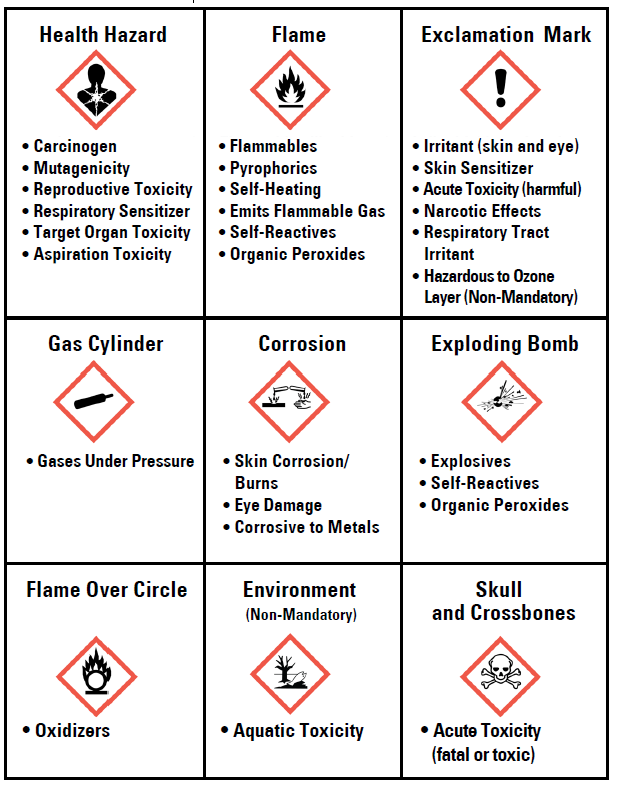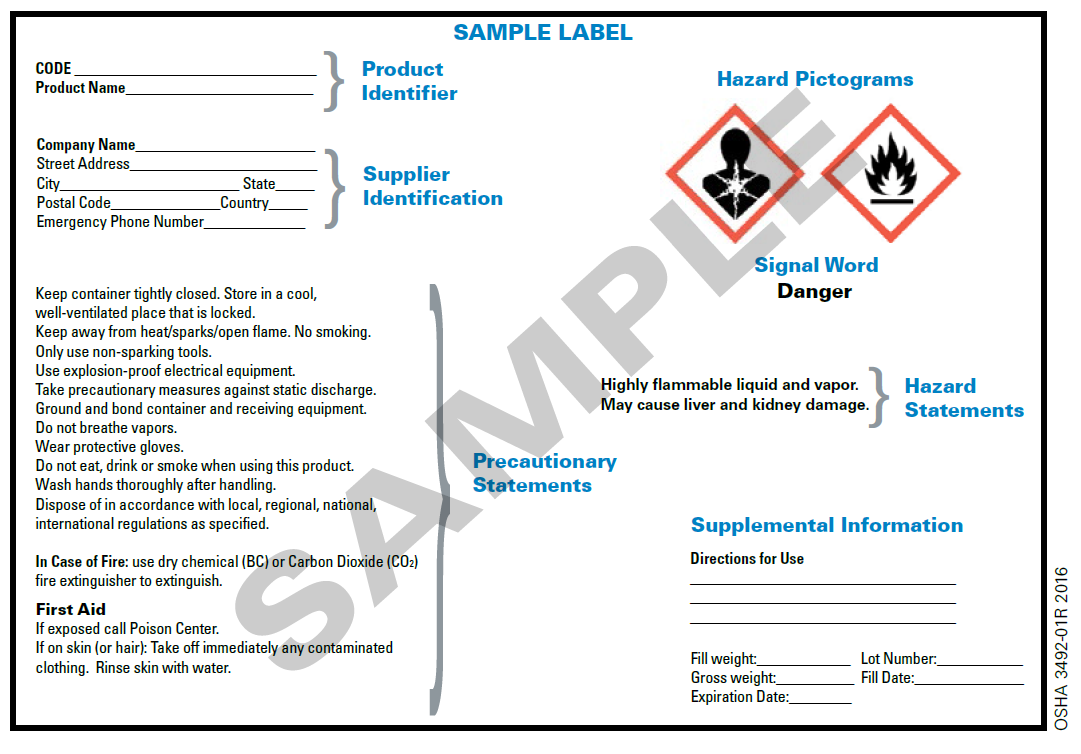what are the signal words used to determine level of severity on the label?
The HazCom Coordinator or designee shall ensure primary and secondary hazardous chemical containers are properly labeled. All labels and warnings should be legible, written in English and prominently displayed on the container.
Primary or Original Manufacturer's Labels
Chemical manufacturers, importers, or distributors are required by OSHA to label, tag or mark each container of hazardous chemicals with the following characterization elements later they classify the hazards of the chemical. Virginia Tech employees must understand how to read and follow chemical labels. Each label has five (5) key elements in add-on to manufacture information:
- Proper noun, Accost and Telephone Number of the chemical manufacturer, importer or other responsible party.
- Product Identifier (how the hazardous chemical is identified) can be (simply is not limited to) the chemical name, code number or batch number. The manufacturer, importer or benefactor tin decide the advisable production identifier. The aforementioned product identifier is found both on the label and in department i of the SDS for whatever given chemical.
- Signal Words alert the reader to the relative severity of hazard posed by that chemic. In that location are only 2 words used every bit indicate words, "Danger" and "Warning." Within a specific adventure grade, "Danger" indicates a more severe level of run a risk, and "Alarm" indicates a less astringent level of take a chance. In that location will just be 1 signal word on the label no matter how many hazards a chemical may accept. If a chemic has more 1 run a risk and one of the hazards warrants a "Danger" point discussion, then "Danger" should announced on the label, fifty-fifty if it'south other hazards warrant the "Warning" signal word.
- Pictograms are graphic symbols used to communicate specific information about the hazards of a chemic. OSHA requires chemical hazards be conveyed via pictograms on primary labels. Each pictogram is adamant by the specific OSHA risk classification(s). Run across OSHA's nine pictograms and respective hazards in the post-obit table below.
- Hazard Statements describe the nature of the hazard(s) of a chemic, including, where appropriate, the degree of run a risk. For example: "Causes damage to kidneys through prolonged or repeated exposure when captivated through the skin." The hazard statements are specific to the run a risk classification categories, and chemical users should ever see the same statement for the same hazards no thing what the chemical is or who produces it.
- Precautionary Statements draw recommended measures to minimize or prevent adverse effects resulting from exposure to the chancy chemical or improper storage or treatment. In that location are 4 types of precautionary statements:
- prevention (to minimize exposure)
- response (in case of adventitious spillage or exposure, emergency response, and first-aid)
- storage
- disposal
- Creating Your Ain Container Labels:
- The full chemical or product proper name(southward) (as information technology appears on the SDS) and the primary or general risk can exist written directly on the container or written/printed on a label to exist affixed to the container.
- For common chemicals/chemical products, yous can use:
- An abbreviation or trade name that is usually used and easily recognized
- A standard chemical formula (not structural formula) that is commonly used and easily recognized
- Always include the primary or general hazard, (Combustible, for example) which can be written directly on the container, or written/printed on a characterization to be affixed to the container.
- If a container is likewise small or identity proper name is too big, a codified name may be used on the container when defined in a notebook or reference canvass that is accessible to all. When many chemical names are needed, readily attainable notebook references may exist used and primary hazards must besides exist communicated in the notebook or in the general work space using give-and-take, symbols or pictograms.
- You lot can even include the five label elements every bit used on primary labels. Notwithstanding, secondary workplace container labels do not require inclusion of the v label elements.
- The primary or general hazards can placed on container labels using words, pictures, symbol or a combination of these that provide full general information about the hazards of the chemical.
- Using Existing Workplace Container Labeling Systems:
- Examples: National Fire Protection Association (NFPA) or Chancy Materials Identification Arrangement (HMIS); the new Globally Harmonized Arrangement of Nomenclature and Labeling (GHS) is also bachelor.
- Whatsoever rating system tin continue to be used as long equally employees have immediate access to the specific hazard information (typically via safe data sheets or container labels) associated with the hazardous material(s). Task-specific training must exist provided to ensure that all employees are fully aware of the hazards of the chemicals used, and how to correctly translate the take chances rating system in use.
- IMPORTANT: Note that the hazard severity ranking within the NFPA and HMIS systems is opposite from the newer OSHA hazard nomenclature severity rankings. NFPA diamonds and HMIS labels range from 0 to iv where 4 is the virtually severe. These labels employ general hazard groups (flammable, health hazard and reactivity or physical hazard). OSHA gamble nomenclature rankings utilise one equally the well-nigh severe category of a given hazard classification and are more specific hazards.
- Secondary Labeling Requirements:
- Every label must convey the required information conspicuously, legibly and in English language. Where other languages are spoken in the piece of work area, data may be presented on labels in other languages in addition to the required English words. Virginia Tech does not mandate any single labeling arrangement.
- There are currently many labeling (marking) systems in use. The best programs utilize a uncomplicated arrangement that is readily recognizable and easily understood. Any worker should exist able to quickly identify the full general gamble of a material and the severity of the hazard by glancing at the characterization.

Labels on incoming containers must not exist defaced or removed until the container is empty. If the label becomes faded, illegible or destroyed they should exist replaced and remain durable, legible, and firmly affixed to the container(s).
The example label depicts the use of all labeling elements:

Secondary or Culling Labeling
The post-obit guidelines summarize the secondary or alternate labeling options bachelor:
Transfer Containers
- When chancy chemicals are transferred from a labeled container to a portable container that is just intended for firsthand use by the individual who performs the transfer, no labels are required for the portable container. Nonetheless, it is best practice to always label secondary containers in the event the user is distracted or a spill occurs. Labeling will eliminate defoliation where at that place are more than one (unlabeled) containers in utilise, and ensure that container content is known in the consequence of an emergency where outside personnel may be involved.
- Transfer container labeling must include the name of the substance and run a risk warnings in a manner consistent with your piece of work areas established culling workplace labeling system.
Source: https://www.ehss.vt.edu/programs/HAZ_warnings.php
0 Response to "what are the signal words used to determine level of severity on the label?"
Post a Comment